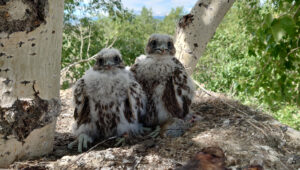Third International Scientific and Practical Conference “Eagles of the Palearctic: Study and Conservation”
Raptors Conservation. Suppl. 2. Proceedings of Conferences
An Adaptive Management Framework Concept for the Sustainable Use of the Saker Falcon
Kovacs A. (Bird of Prey Protection and Research Foundation “Parlagi Sas”, Eger, Hungary)
Galbraith C. (NatureScot, Scotland, UK)
Sheldon R. (RSPB Centre for Conservation Science, RSPB Scotland, Edinburgh, UK)
Gallo-Orsi U., Lopes L. (Raptors MoU Coordinating Unit at Convention on Migratory Species, Abu Dhabi, UAE)
Contact:
Andras Kovacs andras.kovacs.ecol@gmail.com
Colin Galbraith colingalbraith3@gmail.com
Robert Sheldon vanellus1970@yahoo.co.uk
Umberto Gallo-Orsi umberto.galloorsi@un.org
Lauren Lopes lauren.lloydlopes@un.org
Recommended citation: Kovacs A., Galbraith C., Sheldon R., Gallo-Orsi U., Lopes L. An Adaptive Management Framework Concept for the Sustainable Use of the Saker Falcon. – Raptors Conservation. 2023. S2: 465–468. DOI: 10.19074/1814-8654-2023-2-465-468 URL: http://rrrcn.ru/en/archives/35237
Saker falcon (Falco cherrug) is listed on the International Union for Conservation of Nature (IUCN) Red List as Globally Endangered. It breeds across continental middle latitudes, with its range spanning over 7,000 km from Central Europe to Western China, and 3,000 north to south. Most populations are migratory and a number of different routes have been confirmed by field observations and satellite tracking. One of the principal threats affecting its global population is unsustainable trapping/harvest on the breeding grounds and along the migration routes.
The Saker Falcon is listed in Appendix II of the Convention on International Trade in Endangered Species of Wild Fauna and Flora (CITES), which enables trade subject to the development of a Non-Detriment Finding (NDF). Under the Convention on the Conservation of Migratory Species of Wild Animals (CMS), the species is listed under Appendix I (with the exception of the Mongolian population which is listed in Appendix II), meaning that take is generally prohibited, except for the Mongolian population.
The Saker Falcon Global Action Plan (SakerGAP) was adopted by CMS Parties in 2014 and a Saker Falcon Task Force (STF) was established to oversee implementation. One of the key aims of the STF is to develop an Adaptive Management Framework (AMF) that moves the current illegal, and presumably unsustainable trapping activity, into a system that is legal, controlled, and sustainable. Such a system will need to be carefully developed, implemented, and monitored, and conforms with requirements under CMS and CITES. To develop such a framework the STF established an Adaptive Management Framework Discussion Group (AMF DG) to conceptualize a modular AMF as a tool to assist the decision-making of stakeholders, especially international partners, and national authorities, on the sustainable use of the Saker Falcon.
The objective is to design an international AMF which integrates nine modules:
1) global governance and data management, including effective sustainable use models and a sustainable, international quota scheme,
2) internationally harmonized policy and law-making that ensures sustainability,
3) reinforced law enforcement,
4) effective awareness raising,
5) effective monitoring and research schemes,
6) complementary ex situ conservation measures,
7) compensatory in situ conservation measures,
8) effective stakeholder engagement, cooperation, and networking to respond to the socio-economic and cultural drivers of Saker Falcon use, and
9) the involvement of rural communities in the conservation management of the Saker Falcon.
Currently, a significant degree of uncertainty and speculation accompanies the population estimates for certain key Range States, especially in Asia. Therefore, while designing the AMF, the STF is seeking to find a careful balance between the benefits of an internationally coordinated sustainable use framework and the inherent risks of taking Saker Falcons from the wild in large numbers.
According to the draft AMF, the legal harvest may conditionally be allowed in larger, stable, or increasing Saker Falcon populations in parts of its global range, only if legal, ecological, and socio-economic safeguards for sustainability are met and the origin of falcons is identifiable. Depleted or decreasing breeding populations may not currently be considered suitable for any harvest and are illegal as currently listed in CMS Appendix. However, the AMF must mitigate the illegal taking of wild falcons along the flyways and in wintering areas. This would require an international harmonization of alternative policies, and legal and wildlife management tools. As well as a concerted international data sharing to ensure that harvest that is assessed non-detrimental at the Range State level does not affect negatively the Saker Falcon populations of other Range States.

Saker Falcon (Falco cherrug) nestlings in the nest on the artificial platform. Photo by E. Schnayder.
